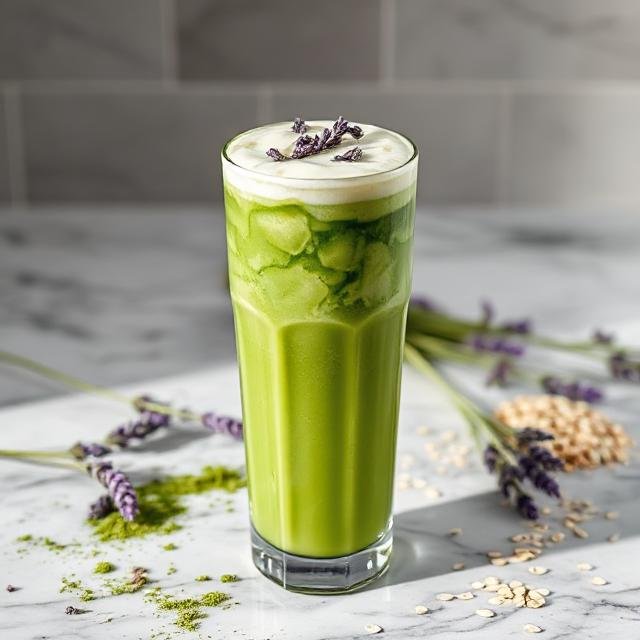The world of specialty beverages has witnessed a remarkable evolution in recent years, with health-conscious consumers seeking drinks that combine both nutritional benefits and exceptional taste. Among the most intriguing innovations is the iced lavender cream oatmilk matcha, a sophisticated beverage that marries the earthy richness of ceremonial-grade matcha with the delicate floral notes of lavender and the creamy texture of oat milk. This unique combination represents more than just a trendy drink; it embodies a holistic approach to wellness that addresses both physical health and sensory pleasure.
Table of Contents
Understanding the Components
Matcha: The Foundation of Excellence
Matcha, a finely ground powder made from specially grown and processed green tea leaves, serves as the cornerstone of this remarkable beverage. Unlike regular green tea, matcha involves consuming the entire leaf, providing a concentrated source of antioxidants, particularly catechins like EGCG (epigallocatechin gallate). The preparation process for authentic matcha is meticulous, involving shade-growing the tea plants for several weeks before harvest, which increases chlorophyll levels and amino acid content, particularly L-theanine.
The quality of matcha varies significantly, with ceremonial-grade matcha offering the most refined flavor profile and highest nutritional density. This premium grade features a vibrant green color, smooth texture, and naturally sweet taste with minimal bitterness. When properly whisked, ceremonial-grade matcha creates a frothy, creamy consistency that forms the perfect base for the iced lavender cream oatmilk matcha.
Lavender: The Aromatic Enhancement
Culinary lavender, specifically Lavandula angustifolia, adds a sophisticated floral dimension to the beverage. This variety is distinct from ornamental lavender and offers a subtle, sweet fragrance with hints of mint and rosemary. The inclusion of lavender in beverages dates back centuries, with traditional uses in European and Mediterranean cultures for both culinary and therapeutic purposes.
Lavender contains compounds like linalool and linalyl acetate, which contribute to its distinctive aroma and potential calming properties. When incorporated into the iced lavender cream oatmilk matcha, lavender should be used sparingly to complement rather than overpower the delicate matcha flavor. The key is achieving balance, where the lavender provides a gentle floral lift without masking the tea’s natural complexity.
Oat Milk: The Creamy Canvas
Oat milk has emerged as a preferred dairy alternative due to its naturally creamy texture and neutral flavor profile. Made from whole oats blended with water and strained, oat milk provides a smooth, slightly sweet base that complements both matcha and lavender beautifully. Its consistency is particularly well-suited for creating the luxurious mouthfeel expected in premium specialty beverages.
From a nutritional standpoint, oat milk offers fiber, particularly beta-glucan, which may support heart health and stable blood sugar levels. It also typically contains added vitamins and minerals, including vitamin D, calcium, and B vitamins. The environmental footprint of oat milk is generally lower than that of dairy milk, making it an appealing choice for environmentally conscious consumers.
The Art of Preparation
Creating the perfect iced lavender cream oatmilk matcha requires attention to detail and proper technique. The process begins with selecting high-quality ingredients and understanding the proper proportions. The matcha should be sifted to eliminate clumps and whisked with water at approximately 175°F to preserve its delicate compounds and prevent bitterness.
The lavender component can be incorporated through several methods. Some prefer creating a lavender simple syrup, which involves gently simmering water, sugar, and dried lavender flowers, then straining the mixture. Others opt for lavender-infused oat milk, created by gently heating the oat milk with lavender and allowing it to steep before straining. Both methods require careful timing to extract the desired flavor without creating an overpowering floral presence.
Temperature control is crucial when combining these elements. The matcha mixture should be allowed to cool slightly before adding the cold oat milk to prevent curdling and maintain the beverage’s smooth texture. Ice should be added gradually, and the entire mixture should be stirred gently to preserve the matcha’s frothy character.
Nutritional Benefits and Wellness Aspects
The iced lavender cream oatmilk matcha offers an impressive array of potential health benefits. Matcha’s high concentration of antioxidants may support cellular health and provide anti-inflammatory effects. The L-theanine content works synergistically with the natural caffeine to provide sustained energy without the jittery effects often associated with coffee consumption.
The combination of matcha’s energizing properties with lavender’s traditionally calming qualities creates a unique balance that may help promote focused alertness while reducing stress. This makes the beverage particularly appealing for those seeking mental clarity and relaxation simultaneously.
Oat milk contributes additional nutritional value through its fiber content and fortified vitamins and minerals. The beta-glucan fiber in oats has been studied for its potential cholesterol-lowering effects and ability to support digestive health.
Customization and Variations
The beauty of iced lavender cream oatmilk matcha lies in its adaptability to personal preferences and dietary needs. Sweetness levels can be adjusted through various natural sweeteners, including honey, maple syrup, or agave nectar. For those following specific dietary protocols, sugar-free alternatives like stevia or monk fruit can be incorporated.
Texture variations can be achieved by adjusting the oat milk-to-matcha ratio or incorporating additional elements like coconut cream for extra richness. Some enthusiasts enjoy adding a small amount of vanilla extract to enhance the overall flavor profile, while others prefer incorporating adaptogens like ashwagandha or collagen peptides for additional wellness benefits.
Cultural Significance and Modern Appeal
The fusion of matcha with Western flavors like lavender represents a beautiful cultural exchange that honors traditional Japanese tea ceremony principles while embracing contemporary flavor innovation. This blend reflects the growing global appreciation for matcha’s ceremonial importance while adapting it to modern lifestyle preferences.
The popularity of iced lavender cream oatmilk matcha also speaks to changing consumer priorities, where wellness, sustainability, and sensory experience intersect. This beverage satisfies multiple contemporary demands: plant-based nutrition, artisanal quality, Instagram-worthy presentation, and functional benefits.
Seasonal Considerations and Serving Suggestions
While enjoyed year-round, iced lavender cream oatmilk matcha holds particular appeal during warmer months when its refreshing qualities are most appreciated. The beverage pairs excellently with light breakfast items like overnight oats, fresh fruit, or pastries. Its sophisticated flavor profile also makes it suitable as an afternoon pick-me-up or a unique offering for special occasions.
The presentation of iced lavender cream oatmilk matcha can be elevated through thoughtful garnishing. A light dusting of matcha powder, a few dried lavender buds, or a delicate oat milk foam art can transform the beverage into a visually striking creation worthy of social media sharing.
Storage and Quality Maintenance
Maintaining the quality of ingredients is essential for consistently excellent results. Matcha should be stored in an airtight container in the refrigerator to preserve its vibrant color and prevent oxidation. Lavender should be kept in a cool, dry place away from direct sunlight. Oat milk should be refrigerated and used within its recommended timeframe for optimal freshness and food safety.
Pre-made lavender simple syrup can be stored in the refrigerator for up to two weeks, making it convenient for regular preparation of the beverage. However, the complete drink is best enjoyed immediately after preparation to maintain its optimal texture and flavor balance.
Frequently Asked Questions
Q: How much caffeine is in an iced lavender cream oatmilk matcha? A: A typical serving contains approximately 70-80mg of caffeine, roughly equivalent to one cup of coffee, though this can vary based on the amount and grade of matcha used.
Q: Can I use regular green tea instead of matcha powder? A: While you can substitute brewed green tea, the result will be significantly different in both flavor intensity and nutritional content, as matcha provides a much more concentrated tea experience.
Q: Is this beverage suitable for people with gluten sensitivity? A: Yes, when made with certified gluten-free oats or oat milk, this beverage is suitable for those with gluten sensitivity. Always check oat milk labels to ensure gluten-free processing.
Q: How can I reduce the sweetness without losing flavor? A: Start with less sweetener and gradually adjust to taste. You can also use the natural sweetness of high-quality ceremonial matcha, which tends to be less bitter than culinary grades.
Q: Can I make this beverage dairy-free and vegan? A: Yes, this beverage is naturally vegan when made with plant-based oat milk and vegan sweeteners like maple syrup or agave nectar.
Q: What’s the best way to incorporate the lavender flavor? A: Lavender simple syrup or lavender-infused oat milk both work well. Start with small amounts and adjust to taste, as lavender can quickly become overpowering.
Q: How long does homemade lavender syrup last? A: Properly stored lavender simple syrup can last up to two weeks in the refrigerator in an airtight container.
Q: Can I prepare this beverage in advance? A: While best enjoyed fresh, you can prepare components like lavender syrup in advance. However, mix the complete beverage just before serving for optimal taste and texture.

